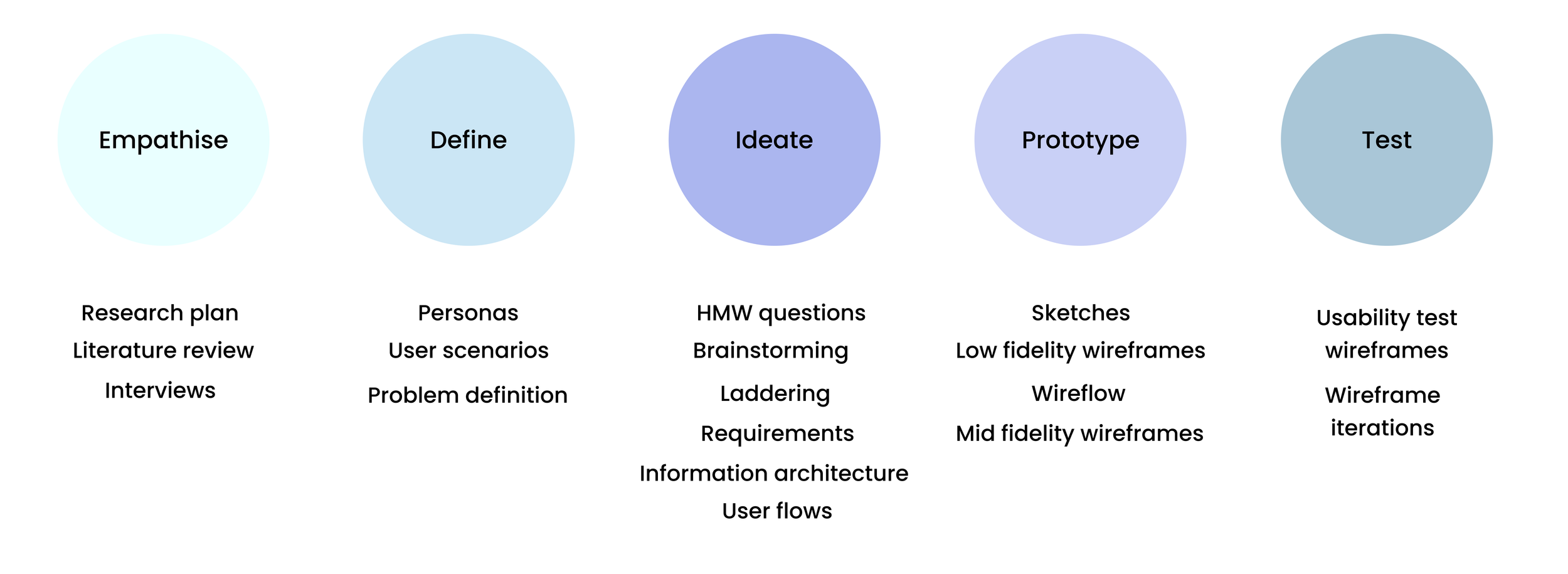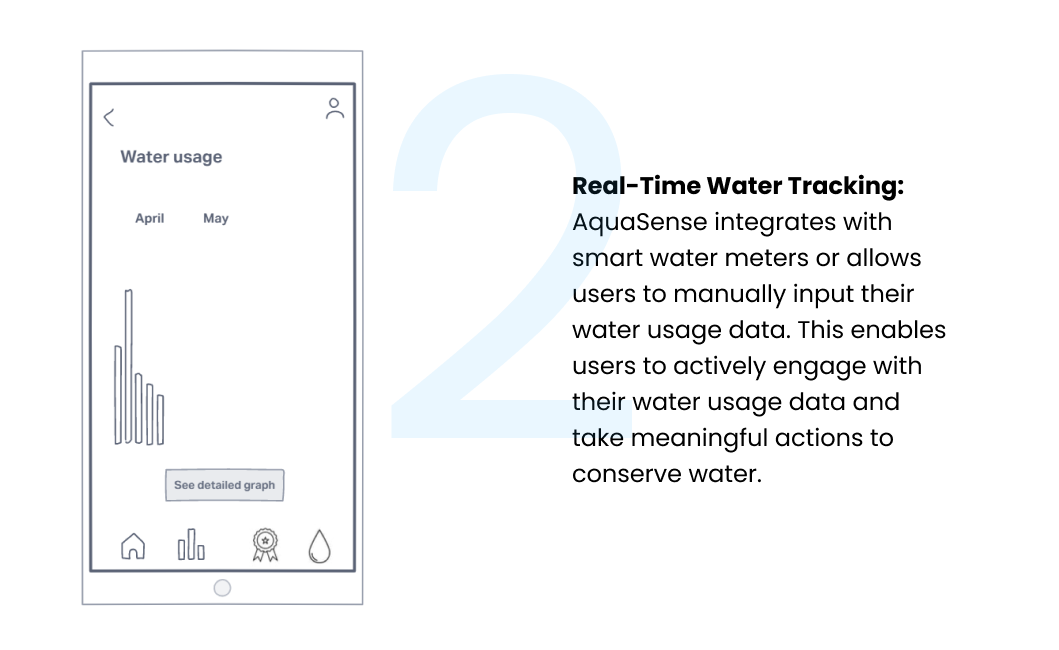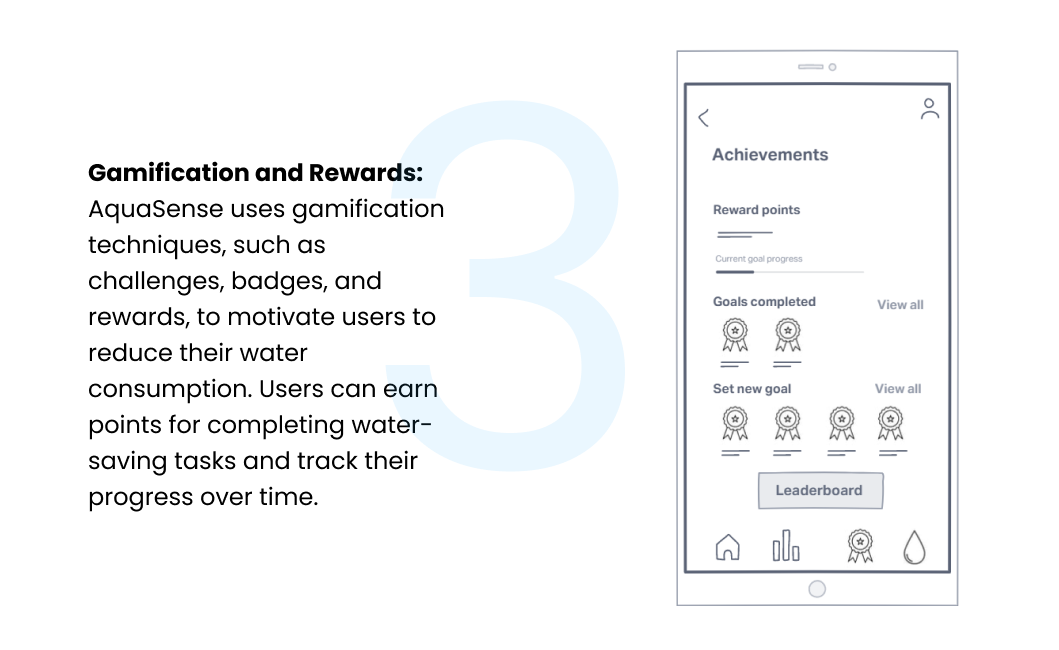
Project Overview
What’s the problem?
Norwegian young adults face challenges in conserving water due to a lack of knowledge, motivation, and accessible tools.
How did I solve it?
By creating AquaSense, an interactive, gamified mobile app that enhances water conservation knowledge, boosts motivation, and provides accessible tools for Norwegian young adults to effectively reduce water usage.
My Role
Solo student semester assignment for Noroff UX design program
Duration
5 weeks
Tools
Miro, Excel, Figma, Invision, Drawio
Design Process
Brief
The world is facing a water crisis. By 2025, half of the world's population will be living in water-stressed areas. Water conservation has become vital, yet many people are unaware of their water usage habits and lack the motivation to reduce their consumption. For this assignment I've been tasked with coming up with a concept for a solution that educates people about water, help alleviate water scarcity and motivate people to reduce their water consumption.
Empathise
User Interviews highlight Lack of Urgency and Incentives Hinder Norwegian Water Conservation Efforts
- Interview Type: Semi-structured interviews
- Number of Interviews: 5 interviews
Key Findings:
1. Daily Use: Common activities include drinking, cooking, cleaning, showering, and dishwashing.
2. Awareness: Rarely considered; awareness often comes from leaks or awareness campaigns.
3. Sustainability: Participants believe their water use is responsible but lack detailed knowledge about water conservation.
4. Actions Taken: Some participants employ water-saving measures; barriers include inconvenience and insufficient information.
5. Waste Reasons: Water is perceived as abundant, with a lack of immediate consequences for wastage.
6. Interest in Learning: Participants are open to practical, accessible information on water conservation.
7. Motivation: Financial incentives and clear, tangible benefits are significant motivators.
8. Government Role: There is a need for stronger regulations and improved public education on water usage.
Conclusion: Norwegians need stronger incentives and better awareness to effectively reduce water usage. AquaSense meets these needs by offering a gamified experience with tailored suggestions and rewards, motivating users and enhancing their understanding of water wastage costs.
Introducing AquaSense: The Mobile App Revolutionizing Water Conservation Through Interactive Tracking, Personalized Feedback, and Gamified Goals. Join the Movement Towards Sustainability!
With AquaSense, you can effectively reduce your water usage, access tailored suggestions, and witness the tangible results of your efforts, all while staying motivated and rewarded through a personalized, gamified experience. Let's make every drop count together!
Define
The target users for AquaSense are environmentally-conscious individuals seeking to reduce water consumption and contribute to sustainability efforts through personalized insights and challenges.
Prototype
Empowering Water Conservation Through Personalized Insights
Drawing from Don Norman's design principles, I ensure their needs are met at every level:
1. Visceral Level: Engaging videos and goal-setting features captivate them, igniting their journey towards water conservation.
2. Behavioral Level: Aligning with their daily routines, AquaSense provides real-time data and personalized suggestions, making water-saving actions seamless and intuitive.
3. Reflective Level: I foster long-term motivation through gamification elements like rewards, competition, and feedback, encouraging sustainable habits that last.
Illustrating User Interface Design with Seamless Wireflows
Step 1: Shows the user the apps logo as a loader and takes the user automatically to the login process when pressing the logo.
Step 2: After logging in the user is directed to the onboarding pages containing three steps. Giving a short intro to feature on the app.
Step 3 + 4: Onboarding Next
Step 5: Onboarding Complete
Step 6: The user clicks on the set your goal button
Step 7: The user sets up their goals in different categories
Step 8: User confirms chosen goal and gets sent to the homepage. The navigation bar has four icons; homepage, water usage, achievements and how to save water.
Step 9: By clicking on this icon, the user will see their profile.
Step 10: User’s water consumption overview.
Step 11: Achievements page with earned points, completed goals and available goals.
Step 12: Shows the users leaderboard.
Step 13: How to save water, showing a short informational video first.
Usability testing insights guided enhancements to the water conservation app, ensuring user needs are met effectively.
Usability testing in the final stage of development aimed to enhance the app's functionality and user experience. Carefully selected participants, matching the target user persona, engaged in tasks like logging in, accessing information, setting goals, and reviewing usage graphs. Moderated sessions encouraged participants to vocalize their thoughts, providing insights into navigation and expectations.
Feedback from testing will drive iterative improvements, ensuring the app effectively supports water conservation practices. Positive feedback highlighted the app's easy navigation, intuitiveness, and clean design.
Miro board displaying quotes from usability test feedback, organized on sticky notes to highlight user insights and pain points.
Improving Navigation, Clarity, and User Experience Based on Participant Feedback
AquaSense: Reflections, Lessons Learned, and Future Directions
Positive User Feedback: AquaSense has received positive feedback for its ease of use, personalized recommendations, and motivating features.
The AquaSense project has provided me with valuable insights and lessons, including:
Learning About User Interviews: This project was one of my first times conducting interviews with users. Understanding the needs, pain points, and motivations of target users through these interviews was essential for creating an effective app.
The Power of Gamification: Implementing gamification techniques proved highly effective in motivating users to change their behavior and conserve water.
Navigation and Design: Overall, navigation was smooth, and participants appreciated the minimalist design of the app.
User Feedback: AquaSense has received positive feedback for its ease of use, personalized recommendations, and motivating features. Participants suggested new features, such as allowing users to make notes within the app and possibly adding a forum for community interaction.
Engaging Quiet Participants: Despite asking participants to think aloud, some were quiet during tasks, making it challenging to gather immediate verbal feedback. I found that allowing them to complete tasks first and then asking questions worked well, as they remembered the screens and completed tasks faster in subsequent attempts.
I have learned the importance of embracing iterative processes. From my former job, what I delivered had to be perfect or at least close to it. Giving out something that is far from finished goes against what I have been taught, but I see the process and how it is effective to get feedback early in the process.
Possible Next Steps
- Community Features: Adding forums or community sections to foster a sense of community and enhance user support and motivation.
- User Customization: Allowing users to make notes within the app for a more personalized experience.
- Social Sharing: Enabling users to share their achievements and water-saving milestones on social media to inspire others.
In conclusion, the AquaSense project has demonstrated the potential of digital innovation to address global water challenges and empower individuals to make a positive impact.
Thank you for reading! 😊
Below are more of my case studies — feel free to explore how I approach different challenges:
Flexop
A Mobile App for Empowering Job Seekers with Flexible Employment
SkySmart
A flight app for mobile and smartwatch
For more work inquiries, or to grab a coffee do email me at irene_luiten@hotmail.com ☕✨













